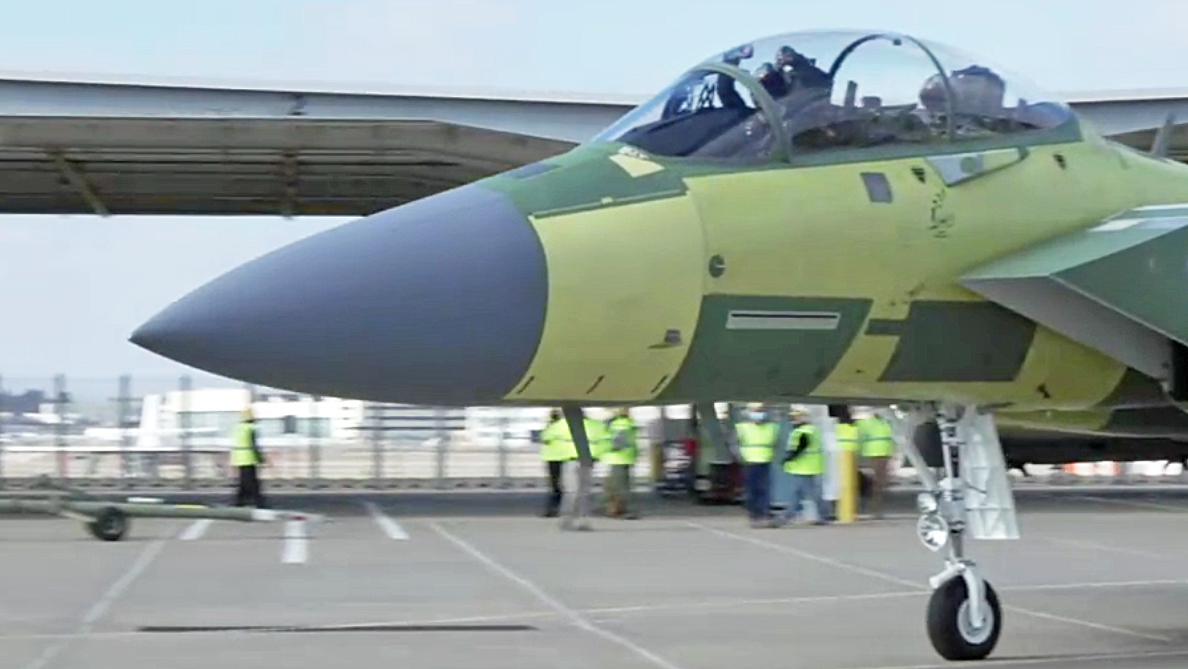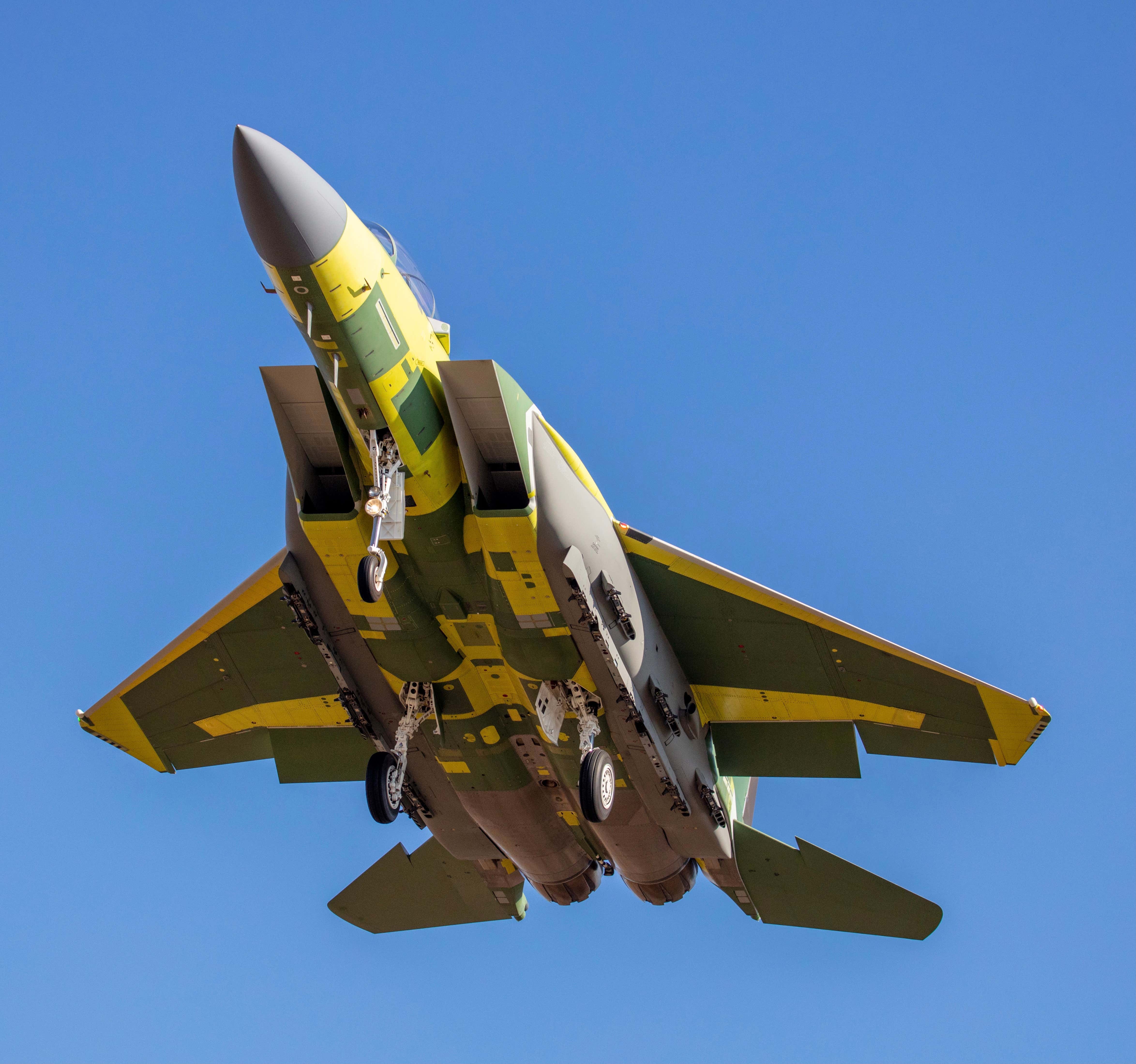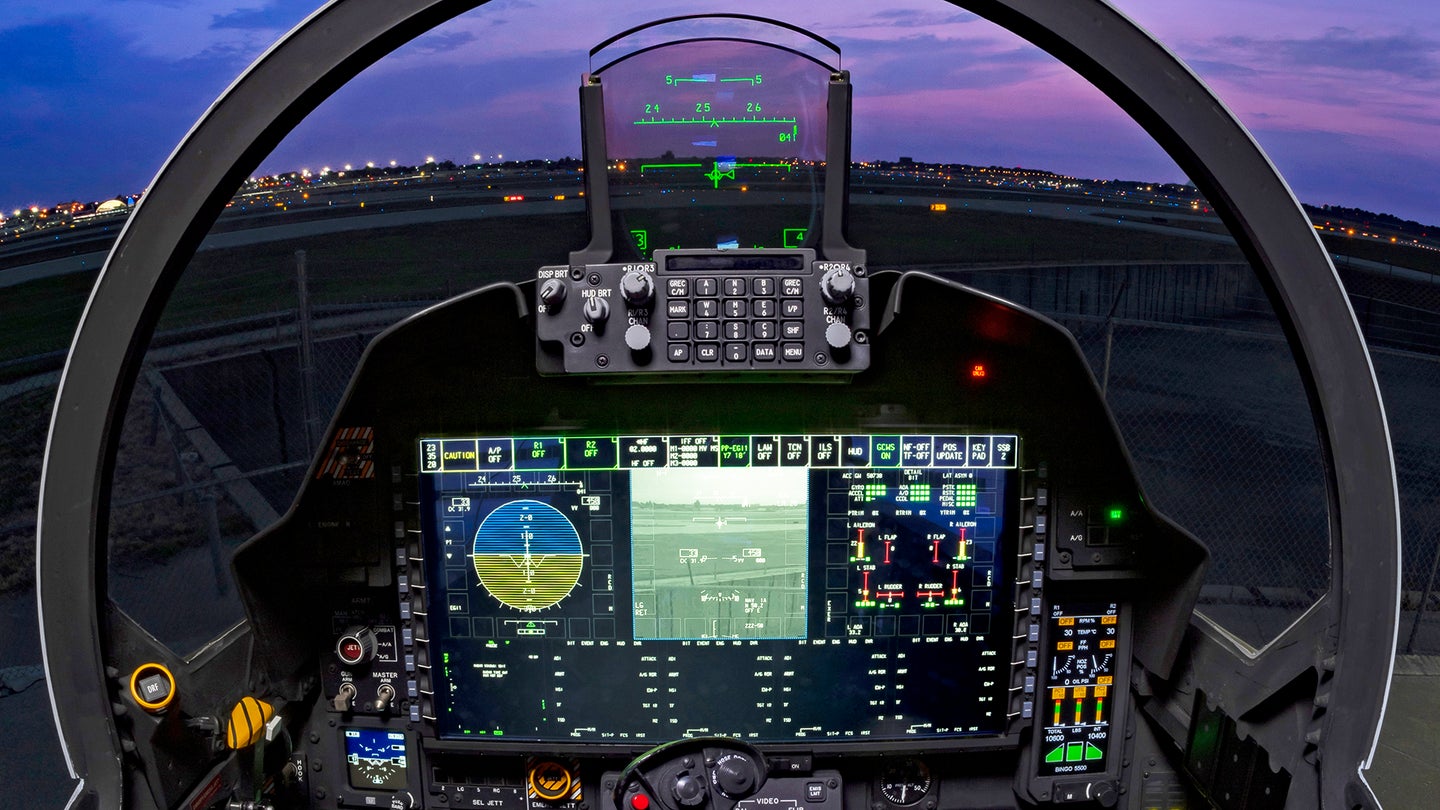“We were confident that in the first 15 minutes of this flight we were going to be up to Mach 2, and that’s exactly what we did,” said Boeing’s F-15 Chief Test Pilot Matt “Phat” Giese who was at the controls for the maiden flight of the first new F-15EX for the U.S. Air Force on February 2, 2021. Giese and fellow test pilot Mike “Houdini” Quintini flew F-15EX-1, as it is known internally, from the Boeing facility at Lambert International Airport in St. Louis, Missouri, for 90 minutes, as part of an effort to ensure the aircraft is ready to be delivered in the first quarter of this year. The War Zone was first to disclose the existence of the F-15EX initiative and evaluate its merits just two and a half years ago.
“This was not a traditional first flight in the sense of a brand new clean-sheet design,” Giese told The War Zone in an interview organized by Boeing after the flight. “It speaks to the maturity of this platform already.” The rationale behind the USAF procuring the two-seat F-15EX is that it is a readily available solution to efficiently recapitalize the aging F-15C/D Eagle fleet. It builds on the baseline F-15QA that is currently in production for Qatar. “We inserted the USAF [Suite 9] Operational Flight Program into the jet, so it was minimal impact on what we would normally do on a first flight. Since we have some maturity already from that platform, the first flight profile [mirrored] very closely what we would do on a normal production acceptance test flight of any jet off the line at St. Louis.”

The first flight of the F-15EX signaled a remarkable milestone in the story of the Eagle, coming nearly 48 years after test pilot Irv Burrows completed the maiden flight of the very first McDonnell Douglas YF-15A on July 27, 1972, at Edwards Air Force Base, California. Just six months later, the USAF approved the Eagle for full-rate production.
“I was getting ready to step to the airplane [when] I got a text message that Irv Burrows was watching the live stream — and I got a chill up my spine,” says Giese. “I recognized the significance of what we did on February 2, which is [to] deliver this brand new platform that has a wonderful almost 49-year legacy now. To have him as a part of that celebration — the first pilot of the F-15 to the newest pilots on the F-15 — it was a momentous event. I had to regroup, refocus, and get back in the game, and of course, we were able to do that nicely.”
Giese says that he and Quintini had to delay the takeoff by around 20 minutes to allow some weather to clear, but then the flight went off without a hitch, describing being at the controls for the first F-15EX mission as “a privilege and an honor.” He adds: “The jet performed as we expected. As a test pilot, this is one of the best things we can do, a first flight, and once you do it no one can take that away from you.”

“We flew [profile wise] our normal Acceptance Test Procedure [ATP] with just a few caveats in the sense that this jet has some instrumentation, [and] some Open Mission System [OMS] cabling, which increases capability. The profile was a ‘Viking takeoff’ right out of St. Louis — and the reason we [did] that on our first flight is that we were confident in how the jet was going to perform. If there was any question at all on how the OFP was going to affect this jet or this specific platform, we would have done a more traditional first flight, which is stay slow, probably leave the gear down for a while, do some powered approach test points and then work your way out to faster up and away approaches.”
“We were so confident this jet was going to perform well we went straight to the ATP — maximum afterburner and pulled-up on a ‘Viking’ — and I had zero problem with that profile and proved it from the start. We went out to what’s called the “Mac North” airspace and executed some flight control checks to make sure the aircraft rig was correct. We climbed up and made sure the jet fuel starter worked on the way up. We got up to 40,000 feet and pushed out to Mach 2. That [speed] is a CFT [Conformal Fuel Tank] limitation. If it was a clean jet we’d go out to Mach 2.5. We did engine checks at 40,000 feet, at 30,000 feet, and then we came down to 20,000 feet and we intentionally shut down the perfectly good engines and then re-started those motors in both primary and secondary mode to prove the reliability of the General Electric GE-129 motors. We had no problems with the re-starts.”

Giese and Quintini then descended for some Visual Flight Rules (VFR) work for the remaining profiles. “We checked the load limiter, the roll limiter, the Environmental Control System, how did the landing gear perform for extension/retraction in both normal and emergency modes, and then we did a bunch of avionics checks,” Giese explained. “How’s the radar working, how’s the electronic warfare system powering-on, are the radios functioning properly, our normal acceptance test procedure — we ran through the rest of that.” Giese points out that the “target” aircraft for the mission — likely a company-owned A-4 Skyhawk — had maintenance issues and was not able to participate in the mission.
“When that was done — not surprisingly — we had extra gas because that’s another big advantage of this platform, the fuel capacity with the CFTs. With that extra gas, Mike Quintini and I decided we deserved a little high alpha maneuvering for our efforts.” Giese says they demonstrated “tailslides and other advanced control and handling maneuvers just to show that this thing is a really good slow-speed fighter in addition to a high-speed fighter.” Giese said he also checked the test instrumentation was “ready to go” so that when the jet is delivered to the customer at Eglin Air Force Base it is immediately available to enter the USAF flight-test program.
“When that was done we hit our bingo fuel and we had to get back to the base with a normal recovery fuel amount. At the same time, the constraint is that we need to demonstrate that the fuel low caution asserts at the appropriate value. We came back to the pattern with enough gas to be safe and return home safely, but then we had the opportunity to use that gas.” Giese flew a series of touch-and-gos and tight close circuit patterns, reefing the F-15EX into tight break turns with the afterburners engaged. Giese says he could see the design and engineering teams watching on the ground. “It was just a privilege to be able to demonstrate that to them and give them several patterns.”
“Right before the full-stop [landing] the fuel low caution asserted on cue. The other thing we check on landing is the anti-skid system. You may have noticed in the video a little puff of smoke as we slowed down below 100 knots — that was me slamming on the brakes like I was getting ready to be in an accident. It kicked-in the anti-skid and allowed us to come to a stop quickly and demonstrate that system was working.”

Giese said the flight threw up some “minor squawks” in terms of maintenance issues “but nothing we wouldn’t normally see on an ATP,” he adds, and nothing that would preclude handing a jet over to a customer. F-15EX-1 is now due to make a customer flight, and the first flight of the second jet is now a focus as Boeing works towards delivering the first two aircraft to the USAF at Eglin in the first quarter of this year to initially join the ongoing Eagle Passive Active Warning Survivability System (EPAWSS) test program.
Read all about what it is like to be at the controls flying the Advanced Eagle that the F-15EX is based on in this previous War Zone exclusive.
Boeing’s flight-test work with the F-15EX is initially limited to the additional test instrumentation, and any other unique wiring and cabling. “These first two airplanes have been laid out with the Open Mission Systems [OMS] high-speed fiber cabling,” explains Giese, referring to the new open avionics architecture that is planned for the F-15EX. The following six Lot 2 production aircraft will additionally feature the OMS processor. “They will have the full capability for the OMS architecture that the USAF has planned for these airplanes,” Giese explains.
“We’re not going to be invited to the fight anymore if we can’t be flexible and we can’t communicate and have agility across platforms. To me, what that means is there’s two ways the F-15 is going to go. One is the immediate need — the Air Force needs [F-15EX] right now for the aging C-model fleet. You’ve got to replace these jets first. As important is the long-term strategic plan the USAF has for this platform, and it is teaming — it is manned/unmanned teaming — so what can the EX do with this OMS cabling and processor that can help all these combatant commanders with these new types of warfare that we’re entering into.” Giese says the OMS makes the F-15EX very “adaptable and flexible,” allowing for rapid changes in mission systems.
“Once you open up the things that are outside the safety-of-flight box, you have the ability to rapidly change things on the fly, maybe even day-to-day in a conflict to react to some sort of threat that’s changing constantly — that’s a huge capability.” Giese says this will enable the F-15EX to react quickly to emerging or unforeseen threats. “As a pilot, I may see a change required in the cockpit for example, maybe it’s a display, maybe I’m not being presented with the information the way that I need to execute the tactical mission. I can relay that back to the engineering teams, and when it’s in an OMS box, they can rapidly change [it]. I can step to the jet maybe the next day, and have that ability to see that new tactical information that maybe I lacked in a previous sortie. So it’s an ability to adapt quicker than we have in the past and to be flexible to any sort of changing or emerging threat.”

The USAF ordered an initial eight new Advanced Eagles under a $1.2-billion deal that was announced in July 2020, and it is set to procure a minimum of 144 F-15EXs under an Indefinite-Delivery/Indefinite-Quantity (IDIQ) contract worth up to $22.89 billion, with 80 of the new fighters planned over the next five years. “Everybody knows the Air Force, and particularly the Air National Guard, needs this new platform,” endorses Giese, adding that comparing early Eagle variants with the F-15EX is like “night and day from a capability perspective.”
“We have the most powerful mission computer processor [in the Advanced Display Core Processor (ADCP) II] in any fighter on the planet today, with room for growth. We have the most powerful radar [Raytheon AN/APG-82(V)1 Active Electronically Scanned Array] that we have ever seen in a fighter. Then you add EPAWSS, which is a brand new electronic warfare capability, which is really what the community needed. You’ve got stations 1 and 9 [allowing a total of] 12 missiles now. I’ve flown it with 12 missiles before and quite frankly I felt like King Kong in the jet. How often we will train like that I don’t know, but having that capability if we need it with a 4-ship going out with 48 missiles is unbelievable!”

The F-15EX also has an extended airframe life out to 20,000 flight hours. “What’s even more important from a longevity perspective is how well this platform is maintained, how safe it is and how reliable it is. We have this new [digital] flight control system that’s easier to maintain — it’s highly reliable. I’ve been flying the digital F-15 since 2013 and I have ground-aborted zero times for flight control problems. We build them easier, quicker, faster, and that ends up with a more reliable platform that — when it ends up on the ramp — aircraft availability goes way up because it just doesn’t break.”
“Maintainers themselves as they train to this new platform, if you go to a new MDS [Mission Design Series — aircraft type] for example, it’s months of training for these young kids to learn the new platform. This is going to take a day. They’re going to learn the new flight control computers, and which LRIs [Line Replaceable Items] to pull and they’re going to recognize they won’t have to pull them that often—it’s a very quick transition. So from the impact of the flight line itself, it will be minimal if not zero.”
“I believe this is the most lethal and survivable jet that’s on the market today and I say that because the battlespace effects that this airplane can provide are on par or exceed what you can do with an LO [low observable] platform that has restrictions. This jet has 30,000 lb of things we can put on the wings and the fuselage,” adds Giese. “No one’s going to match that. Then if you marry that up with the radar and the EW system, I would argue — even as a guy that flew the F-22 for 12 years — that this platform produces battlespace effects — which is what the commanders care about — that are equal or better than what an LO platform can do, that’s based on power, size, payload, and capacity.”

The fact that the USAF has not purchased any new Eagles since the last F-15E Strike Eagle was delivered in the early 2000s, and that fighter procurement has focused on low observable (stealthy) platforms such as the F-22A Raptor and F-35A Lightning II from Lockheed Martin in recent years, makes the domestic F-15EX buy particularly important to Boeing. The F-15EX is all about the simplicity of transition from the F-15C, tapping into existing pilot training and infrastructure to fast-track entry into service, and save a lot of money in the process of doing so. The first operational F-15EX unit is planned as the Air National Guard’s 142nd Fighter Wing, based in Portland, Oregon, which will receive its first jets in 2023. From contract signature to fielding, the F-15EX program is on a par with that original Eagle fielding that went from its first flight in 1972 to service entry two years later.
“Mike Quintini and I recognized the significance of the event,” Giese says reflecting on the first flight on February 2. “We had to take a moment as we were stepping to the jet — we stepped aside in a room, and we looked at each other and realized how important this really was. What a significant event this really was to start selling F-15s to the USAF again after a couple of decades. From pen to paper a couple of years ago, to where we were on February 2 was a whirlwind — it happened really, really fast. But we did it safely and reliably.”
“My cellphone was hot on Wednesday night — I got so many phone calls from guys who were excited about the new platform. In fact, one of the senior F-15C pilots in the community who is stationed at Eglin and who is going to be receiving these first two airplanes called me. I haven’t flown with him in a decade and he asked me a ton of questions about the aircraft and how it performed — he was giggling like a child at my answers. You’ve got these senior guys in the community right now that are just really excited about this platform.”
“Doing a first flight is a highlight in a test pilot’s career — in fact, it’s kind of the pinnacle in a career to do something like this, and although I’ve done a few first flights before, this by far surpasses anything I’ve ever done in my flight-test career.”
Regardless of personal firsts, the Air Force’s new advanced Eagle is now a reality.

Contact the editor: Tyler@thedrive.com
